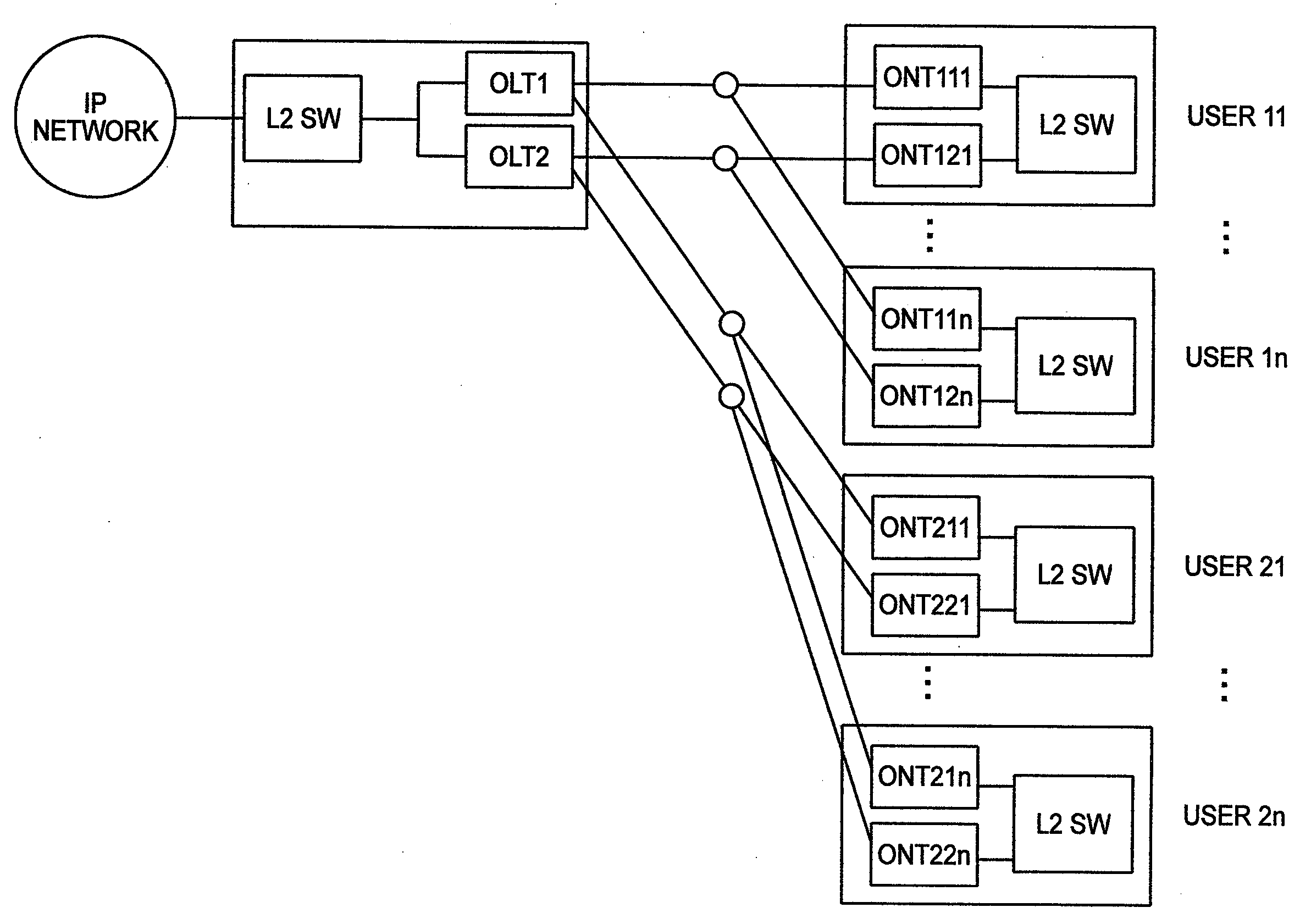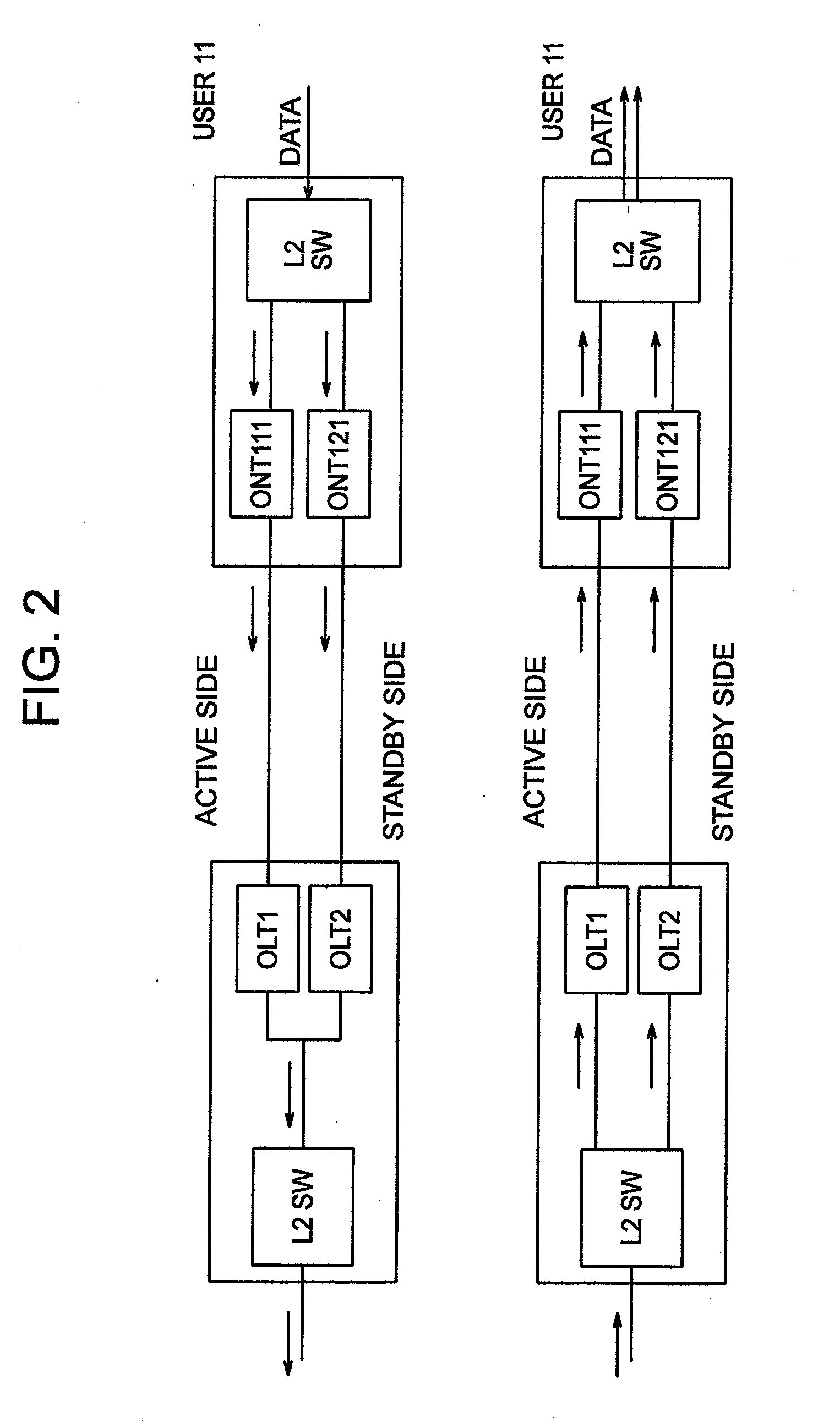Network systems and communications equipment
a network system and communication equipment technology, applied in the field of network systems and communications equipment, can solve the problems of loss of bandwidth, loss of autodiscovery procedure, loss of data bandwidth, etc., and achieve the effect of ensuring precise bandwidth and data loss
- Summary
- Abstract
- Description
- Claims
- Application Information
AI Technical Summary
Benefits of technology
Problems solved by technology
Method used
Image
Examples
embodiment 1
[0049]FIG. 1 is a figure of a network system that is a prerequisite of the present invention. Assume that all the users have implemented the 1+1 protection. A user 11 has implemented the 1+1 protection using a combination of OLT1 and ONT111 as well as OLT2 and ONT121. Likewise, a user in has implemented the 1+1 protection using a combination of OLT1 and ONT11n as well as OLT2 and ONT12n. Hereinafter, although the user 11 will be described, the same description is completely applied to other users, as well.
[0050]FIG. 2 shows an actual communication data flow in the redundant system of FIG. 1. Here, assume that OLT1 and ONT111 are on the actual side and OLT2 and ONT121 are on the standby side. In the direction from ONT to OLT, first, data is copied by L2SW and input to ONT111 and ONT121, respectively. These data pass through optical fibers and reach OLT1 and OLT2, respectively. The active OLT1 sends the received data as it is, while the standby OLT2 discards the data. This can prevent...
embodiment 2
[0076]Moreover, as a second embodiment, a case of using WDM (Wavelength Division Multiplexing) using a plurality of wavelengths of light is shown in FIG. 26. OLT1 and OLT2 communicate with ONT by using different wavelengths, respectively. Both OLT1 and OLT2 use two wavelengths, respectively, i.e., a total of four wavelengths are used here. The lines forming the redundant system by OLT1 and OLT2 are combined by MuxDemux 2601 and connected to one optical fiber. With lights of different wavelengths over this one optical fiber, two kinds of communications of OLT1 and ONT111 as well as OLT2 and ONT121 are multiplexed, for example. This embodiment corresponds to a case where the 1+1 protection system is implemented with one optical fiber by using WDM. Also here, completely the same as the foregoing description is applied. FIG. 27 shows an example of the table of management information 1005 in this embodiment. This table is the same as that of Embodiment 1 except that the currently-used wa...
embodiment 3
[0077]As a third embodiment, a case where a certain failure occurs in OLT and the switching active side is performed is shown in FIG. 28, FIG. 29, and FIG. 30. FIG. 28 shows the timing of switching active side, FIG. 29 shows the PON receiving function of OLT, and the others are all the same as those of Embodiment 1. A difference between FIG. 28 and FIG. 7 lies in that a notification of a time of failure occurrence is received in stead of reading the next starting time of autodiscovery procedure from the table of management information. Accordingly, the function of switching active side 1002 in OLT notifies the PON receiving function of OLT 1004 of the last time of grant before the failure occurrence. Moreover, when detecting the sequence of the last data in the receiving queue 1103 in the PON receiving function of OLT 1004 of FIG. 29, the queue may be empty depending on the timing. For this reason, a memory function of sequence number 2901 for storing the sequence number of the last...
PUM
 Login to View More
Login to View More Abstract
Description
Claims
Application Information
 Login to View More
Login to View More - R&D
- Intellectual Property
- Life Sciences
- Materials
- Tech Scout
- Unparalleled Data Quality
- Higher Quality Content
- 60% Fewer Hallucinations
Browse by: Latest US Patents, China's latest patents, Technical Efficacy Thesaurus, Application Domain, Technology Topic, Popular Technical Reports.
© 2025 PatSnap. All rights reserved.Legal|Privacy policy|Modern Slavery Act Transparency Statement|Sitemap|About US| Contact US: help@patsnap.com



